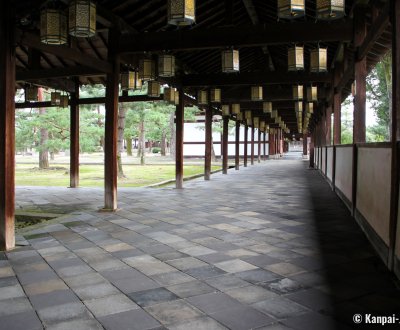Manpuku-ji
Chinese Zen Temple in Uji
Manpuku-ji is a Zen Buddhist temple located in Uji, in the south of Kyoto in Japan. The architecture of the Obaku sect’s head-temple reflects a strong Chinese inspiration in a large enclosure whose spirituality remains undisturbed by mass tourism.
Manpuku-ji temple is located at Obaku station on the Nara JR line, one train 🚅 stop away and slightly off the touristic center of Uji and its green tea shops along the road to the Byodo-in. As this position is less attractive for tourists crowds, it allows the discovery of a very quiet and special Zen Buddhism temple in Japan.
Manpuku-ji is the main monastery of the Obaku school, the smallest Japanese Zen sect, lesser known than the Rinzai and Soto schools. It was founded by Chinese monk Yinyuan Longqi, named Ingen Ryuki (1592 – 1673) in Japanese, who came to Nagasaki in 1654 at the invitation of the local Chinese community, at the beginning of the Edo period (1603 - 1868).
A few years later, Tokugawa Ietsuna, the 4th shogun of the ruling Tokugawa dynasty, granted Ingen Ryuki a piece of land at the foot of Mount Obaku in Uji, in order for him to settle definitely in Japan and never return to his homeland. Manpuku-ji temple is established in 1661 following the Zen tradition of the Great Ming dynasty (1368 – 1644), the period during which Ryuki became an acknowledged spiritual leader in China.

Heritage of Ingen Ryuki’s Zen Obaku thinking
The temple’s pavilions have a distinctive look, displaying a Chinese architecture quite different from the Japanese’s, for example:
- The main hall Daiohoden is a large construction made of teak wood naturally sourced in Southeast Asia and showing 2 round windows at its front;
- The roof of the Somon gate has a raised central part.
Patterns of swastika 卍 (manji in Japanese) Buddhist crosses s are also carved on the balustrades of several prayer buildings.
Likewise, Obaku’s teachings, considered more modern and less codified than those of the other Zen Japanese schools, as well as lifestyle, reflect the Chinese culture of the times. Therefore, the monastery serves a vegetarian cuisine of Chinese inspiration, called fucha ryôri in Japanese. Visitors can book a seat at the restaurant at least 3 days prior to the date of their visit, and can expect a choice of several hearty menus filled with vegetal proteins.
Ingen Ryuki is also said to have introduced several fruits and vegetables in Japan, such as the common green beans (Phaseolus) that were named after him in Japanese: ingen-mame ("Ingen’s beans").
The temple’s community life and daily rituals are paced by the rhythm of the drum, which is shaped in a big wooden fish hanging from a beam called gyoban. The Manpuku-ji grounds are also well-known for their many lotus that blossom in summer and a beautiful gilded statue of Hotei, one of the 7 Lucky Gods originating from Chinese Buddhism.


